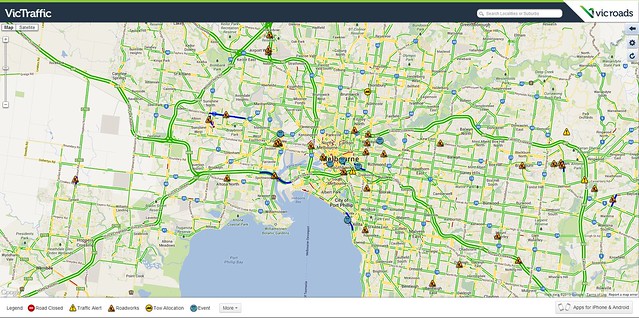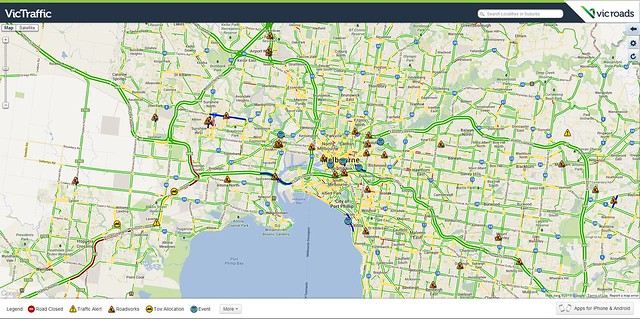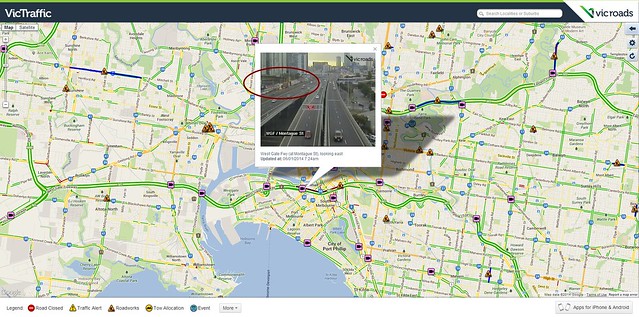GRIDLOCK will begin to choke Melbourne’s roads from Friday night, but the full impact of bridge and tunnel closures for maintenance won’t bite until the New Year.
Motorists are being advised to steer clear of the city, or they could experience delays of up to an hour.
— Herald Sun: Traffic chaos expected as West Gate Bridge and CityLink tunnels close, 26/12/2013
Oh noes! The Domain tunnel (that’s westbound) closed for days! Disaster!
Except… gridlock? What gridlock?
Here’s how it looked at 8am this morning on the Vicroads live traffic web page:
A few little spots of delays marked in red, but nothing major at all. (Click on the pictures to see them bigger.)
On Saturday, the only major delays were miles away from the tunnel, due to incidents on the Princes Highway westbound.
This photo this morning from a Channel Ten reporter also noted a distinct lack of chaos.
No sign of traffic chaos (yet) with the closure of the Domain Tunnel @tennewsmelb pic.twitter.com/t8coejuPWs
— Leah Craven (@leahcraven) December 29, 2013
There are probably a number of reasons for this. Firstly the timing of these works was wisely scheduled when fewer people are travelling around town.
But I also wonder if the widespread publicity of the closures has led to people purposefully avoiding it. After all, if you know in advance there’s a major road closure, why would you deliberately drive into a snarl if you could avoid it?
Turns out major road closures often result in no gridlock
Turns out this is not unprecedented. In 2007 a major shutdown in Seattle resulted in… no gridlock.
I mean, who’d have guessed you could shut down a third of our most congested freeway and not paralyze the region in epic traffic jams? Oliver Downs, that’s who.
The case of the vanishing cars is no mystery to him. In fact he predicted it.
…
He forecast no extreme clogs anywhere — not on I-5, nor on alternate routes such as Highway 99 or 599. So far he’s been right about that.— Seattle Times: Math whiz had I-5’s number, 22/8/2007
And a recent major shutdown in Birmingham, that also resulted in little disruption, has many wondering if these big inner-city motorways are needed at all.
When it emerged Birmingham’s Queensway tunnels would be closed for six weeks over the summer, it is no surprise there were predictions of “chaos”.
The main through route for the A38, the tunnels are used by thousands of drivers each day and have been an integral part of the city’s transport network since they were built in the 1970s.
There was some surprise, therefore, when the anticipated gridlock did not materialise.
The reality was so different that a report into Birmingham’s transport network for the next 20 years has called for a debate about how much they are needed, pointing out they create a “noisy unattractive barrier to intra-centre movement”.
— BBC: End of the road? Are major routes through cities outdated? 26/12/2013
This has even happened in Los Angeles:
The traffic many thought would be a nightmare was much lighter than normal as Los Angeles entered the second day in the shutdown of a 10-mile stretch of Interstate 405 – one of the country’s busiest highways.
Associated Press: Los Angeles bridge project cruising toward finish, 17/7/2011
This phenomenon has been studied, and it’s actually quite common.
In 1998, British researchers studied what happened to traffic in more than 100 highway and bridge shutdowns in Europe and the U.S. They found that on average 25 percent of all car trips simply evaporated.
People still went to work. Some commuters drove, some found another way in. Some other trips were just not made.
“Drivers are not stupid,” Downs says. “They change schedules. They don’t take some trips, or they delay them. The net effect of all these little decisions can be dramatic.”
— Seattle Times: Math whiz had I-5’s number, 22/8/2007
Is this the opposite of induced traffic?
Induced traffic happens when large numbers of people decide it’s easier to drive, and do so, more often and further. It’s commonly seen when new major roads open, as often congestion initially falls, before building back up.
As I mentioned above, demand is definitely lower at this time of year, with many city workers on holiday. But VicRoads says this typically results in only a 30% drop in traffic levels… so normally 70% of the traffic volumes would still be on the roads.
It might be that in the case of the current Domain tunnel closure, with plenty of advance publicity, large numbers of people may have decided not to make some trips, at least not by car.
The real test might be next week when the Burnley tunnel is closed, and a lot more people are back at work.
But as with the questions being asked in Birmingham, what we’ve seen so far again calls into question the wisdom of building more major inner-city roads such as the East West Link. Ultimately, do we need more of them, especially with a price tag of billions of dollars? Shouldn’t we be smarter about how we provide mobility for large numbers of people (and goods) in a more efficient manner?
Update 31/12/2013
I’ve been looking through the TV news from the last couple of nights. Here are some choice quotes.
In a story introduced with the phrase “Carmageddon”: “I think people are well informed, and I think they understand that when we do have virtually a single major link – Citylink and Westgate – that does occasionally have to be shut down. And that’s why the people of Victoria say get on and build the East West Link.” – Dennis Napthine, Channel 7 news, 27/12/2013
“Melbourne has escaped traffic chaos on the first day of the city’s biggest road network closure. Drivers didn’t face the hour-long delays that were forecast…
…
With an average 9000 cars using that stretch of Citylink every hour, Victorians were warned there’d be chaos and long delays. But it seems that was enough to keep most drivers off the roads.
…Monday tipped to be an especially busy day as many Victorians return to work.”
Update 6/1/2014
Warnings continued over the weekend for the closure of the Burnley (eastbound) tunnel, and minor queues from Westgate onto Kingsway were noted on Saturday, but still major delays have proved elusive.
This morning, arguably the first day there are lots of people returning to work, the Vicroads traffic web site does show a queue about 2km long in that same spot. It’s still not widespread gridlock, though it’ll be interesting to see if it spreads through the day, and particularly in evening peak.
By 8am the queues stretched back to about the service stations, but there was little other congestion noted in the inner area.
The ABC reported it thus: Closure of Burnley Tunnel for resurfacing work causes only minor traffic delays
Perhaps the delays are only this minor because the authorities talk up the chaos. But as noted above, it should leave us questioning the Premier’s claims that it is critical to build another cross-city tunnel.



6 replies on “Domain tunnel closed. Gridlock? What gridlock?”
Denis Napthine on 774: “And you can imagine Melbourne without CityLink today, it would be an absolute gridlock mess”
http://www.premier.vic.gov.au/media-centre/transcripts/6829-full-transcript-of-premier-denis-napthine-s-interview-on-abc-774-mornings-with-jon-faine-08-may-2013.html
My train home from the city on Monday 23rd was packed due to fewer timetabled trains. Now that’s CHAOS !
Remember the 2007 fire in the Burnley Tunnel when it was closed for some time? Traffic chaos was predicted. A Vic Roads spokesperson said he was not too concerned. He went on to say Kingsway, Queens Road and Dandenong Road have the ability to move huge volumes of traffic out of the city. Traffic was certainly heavy and slow, but it kept moving.
The more I learn about the East West Tunnel, the bigger the waste of money it seems to be, never mind the terrible impact it will have on some residents. I don’t think I am wrong in calling it the Fox Tunnel. For inner northern suburban residents, you may see a bit less traffic for a while, but in time it will build back up again. There are countless examples to prove the point.
I’m surprised you didn’t mention the Cheonggyecheon river restoration project, probably the best known example of urban freeway removal in recent years and a project that actually improved traffic conditions afterwards.
Behind a paywall I’m afraid, but you can read the abstract: The loss of road capacity and self-compliance: Lessons from the Cheonggyecheon stream restoration.
That map looks like two people quarrelling.
Drove across town yesterday, including CityLink (although obviously not including the tunnel). If there were delays, they were imperceptible to me.